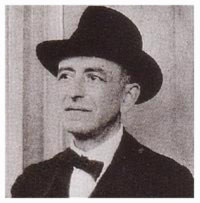







Manuel de Falla was born in Cádiz. His early teacher in music was his mother; at the age of 9 he was introduced to his first piano professor. From the late 1890s he studied music in Madrid, piano with José Tragó and composition with Felipe Pedrell. In 1899 by unanimous vote he was awarded the first prize at the piano competition at his school of music, and around that year he started to use "de" with his first surname, making de Falla the name he became known as from that time on.It was from Felipe Pedrell, during Madrid period, that de Falla became interested in native Spanish music, particularly Andalusian flamenco (specifically cante jondo), the influence of which can be strongly felt in many of his works. Among his early pieces are a number of zarzuelas, but his first important work was the one-act opera La Vida Breve (A Brief Life, written in 1905, though revised before its premiere in 1913). De Falla spent the years 1907 to 1914 in Paris, where he met a number of composers who had an influence on his style, including the impressionists Maurice Ravel, Claude Debussy and Paul Dukas. He wrote little more music, however, until his return to Madrid at the beginning of World War I. While at no stage was he a prolific composer, it was then that he entered into his mature creative period. In Madrid he composed several of his best known pieces, including:
•The nocturne for piano and orchestra Noches en los Jardines de España (Nights in the Gardens of Spain, 1916)
• The ballet El Amor Brujo (The Love Magician, 1915) which includes the much excerpted and arranged Ritual Fire Dance
• The ballet El Corregidor y la Molinera (The Magistrate and the Miller's Wife) which, after revision, became El Sombrero de Tres Picos (The Three-Cornered Hat, 1917) and was produced by Serge Diaghilev with set design by Pablo Picasso.From 1921 to 1939 Manuel de Falla lived in Granada, where he wrote the puppet opera El Retablo de Maese Pedro (Master Peter's Puppet Show, 1923) and a concerto for harpsichord and chamber ensemble (1926). In these works, the Spanish folk influence is somewhat less apparent than a kind of Stravinskian neo-classicism.
Also in Granada, de Falla began work on the large-scale orchestral cantata Atlántida (Atlantis) based on the Catalan text L'Atlàntida by Jacint Verdaguer, which he considered to be the most important of all his works. Verdaguer's text gives a mythological account of how the submersion of Atlantis created the Atlantic ocean, thus separating Spain and Latin America, and how later the Spanish discovery of America reunited what had always belonged together. De Falla continued work on the cantata after moving to Argentina in 1939. The orchestration of the piece remained incomplete at his death and was completed posthumously by Ernesto Halffter.
De Falla tried but failed to prevent the murder of his close friend the poet Federico García Lorca in 1936. Following Francisco Franco's victory in the Spanish Civil War, de Falla left Spain for Argentina. He died in Alta Gracia, in the Argentine province of Córdoba. In 1947 his remains were brought back to Spain and entombed in the cathedral at Cádiz. One of the lasting honors to his memory is the Manuel de Falla Chair of Music in the Faculty of Philosophy and Letters at Complutense University of Madrid.
(Wikepedia)


Home | Books | Sheet music for guitar | Visual arts | Biography | Syukhtun
Copyright © 2002 Syukhtun EditionsTM, All Rights Reserved
syukhtun.net domain name is trade marked SM , All Rights Reserved